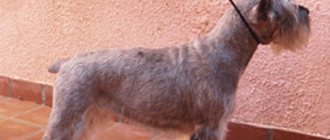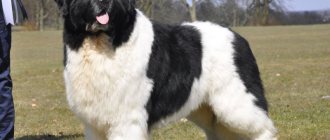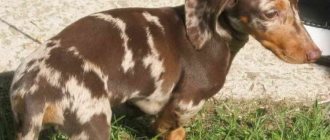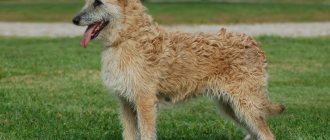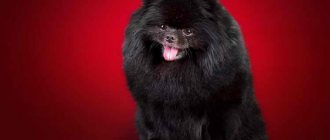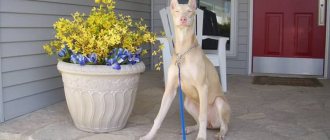In England in the 18th century, cynologists developed a special breed of dog to fight rodents, called the “English Toy Terrier.” At the end of the 19th century The breed has become popular in Russia among wealthy people.
During the October Revolution, along with the nobles, their pets were exterminated, which had a detrimental effect on the population of English toy terriers. In the middle of the 20th century, domestic dog handlers decided to revive decorative dog breeding. In 1957, in a litter of two smooth-haired dogs, a baby was born with hair on his paws and ears, which was not typical for this breed. Moscow cynologists became interested in the spectacular puppy and began breeding a breed called the “Russian Longhaired Toy Terrier.”
Dossier
Adult height: from 20 to 28 cm. Weight: no more than 3 kg. Characteristic color: brown, red, blue and tan. Coat length: longhaired. Life expectancy: up to 18 years. Advantages of the breed: compact, cheerful, loves to spend time in the company of the owner. Difficulties of the breed: susceptible to stress, loves to voice. Average price: up to $200 for a regular puppy; $500 for a puppy with a pedigree. Classification: small breed; companion dog.
Origin story
The Russian Toy Terrier was bred thanks to the efforts of Moscow dog handlers who tried to restore the number of representatives of the English Toy. However, the dogs used for this were not purebred, so their offspring had slightly different characteristics.
The first livestock of the new breed appeared in Russia in the 50s of the 19th century. The main task of the specialists was to create a completely different group of dogs, which would have its own generally accepted standard, different from the standard of the English breed. This is how the world saw the Russian Longhaired Toy Terrier. This dog has gained popularity very quickly, thanks to their compact size and cute appearance. In 2006, the breed was recognized by the International Canine Association.
Character
Despite its small size, the Russian Longhaired Toy knows no fear. He is always ready to fiercely defend his master. And when meeting a larger dog, this little one will definitely climb up to it first. You can rest assured that a representative of this breed will always be ready to protect your home from strangers.
When describing the character of the Longhaired Russian Toy Terrier, it is important to note that this breed has a crazy temperament. This is a rather impatient, although very smart dog. She needs constant physical activity to spend her energy in the right direction. She doesn't get along well with children. Noisy companies quickly tire him. He also cannot stand quarrels and scandals in the family.
By color
The official description of the breed initially mentioned one possible color - black and tan. Gradually the color palette expanded. Currently the color list includes 11 tones. Among them are different variations of tans:
- brown and tan;
- lilac and tan;
- blue-gray tan.
In cynology, tan is usually called the lighter-colored areas of fur that stand out against the general background and have a constant location. In Toychiks, tan marks are most often visible above the eyebrows and on the face, chest and paws.
The photo shows a smooth-haired Russian Toy with a lilac-tan color.
One of the most common colors is red, with the addition of black, brown, chocolate, cream, lilac and blue. In any combination, the color tonality should be rich. Snow-white color and white spots are considered a defect of the animal.
How to choose a puppy
From the age of one and a half months, long-haired toy terrier puppies are completely ready to move to a new home. At this point, the dog has already been given an identifying mark in the kennel and the necessary vaccinations have been given.
When purchasing, pay attention to the puppy's appearance and character. The baby should be active, cheerful and have a good appetite. Decide on the purpose of purchasing a puppy. Its cost and exterior will depend on this. If you are not taking a dog for breeding, then it does not need a pedigree.
Choosing a dog
Taking into account all the characteristics of the breed, experts do not recommend purchasing a puppy on the spontaneous market, as there is a risk of becoming the owner of a sick dog. For a dog that has a beautiful color, it is better to go to a specialized nursery.
In this case, you should definitely pay attention to the health of the dog’s parents. All small puppies should be agile, timid and active. They must be examined carefully: there should be no discharge from the ears, nose, or eyes. Experts do not recommend purchasing a tot terrier less than 3 months old. The first days of his life it is better for him to be near his mother.
If the dog becomes a participant in exhibitions in the future, it is necessary to check it for the presence of defects, which include: lack of hair on the ears, malocclusion, the presence of white spots, short legs, bald patches, drooping ears. It is advisable to find out from a specialist about what a healthy dog looks like.
From incredibly beautiful dogs, one of which had long hair, a puppy was born in 1958 with feathering on his ears and limbs
Care and maintenance
The Russian Longhaired Toy Terrier is a decorative dog, it is only suitable for keeping in a house or apartment. However, you should immediately accustom your pet to walks outside so that he does not go to the toilet at home. This breed is not litter trained well and will frequently void on furniture or carpets in the future.
When caring for a toy terrier, it is recommended to follow the following rules:
- The Russian Toy Terrier does not require special coat care. It will be enough to brush the dog 1-2 times a week, and you can bathe it after every walk. When bald spots appear, rub burdock oil into your pet's fur.
- Check your toy's ears once a week for dirt, ear infections, or mites.
- Regularly wipe your pet's eyes to prevent accumulated dirt from leading to infection.
- Trim your dog's nails once a month, as long-haired toy terriers are not accustomed to sharpening them themselves.
- In cold weather, be sure to wear special overalls on your dog.
Nutrition
The Russian Toy Terrier, like most dogs of its size, has a very sensitive digestive system and is prone to overeating. It is necessary to carefully monitor your dog's diet. If you feed your pet natural foods, then most of them should be protein foods. Also, don’t forget about vegetables, fruits, cereals and dairy products.
As for prohibited foods for the toy terrier, these include:
- sweets;
- bakery;
- smoked meats;
- salty food;
- butter and sour cream.
Russian Toy Terrier puppies under the age of 6 months need to be fed 4-3 times a day, and after six months it is worth switching to 2 meals a day.
Health
Characteristic diseases
For a comfortable life and good mood, toys only require the attention of the owner, good food and walks.
The most common diseases are:
- dislocation of the kneecap;
- cataracts and other eye diseases;
- ear infections.
You can learn how to properly clean a dog's ears from the article.
Allergies in this breed are extremely rare.
Advice ! It is not recommended to buy toys for small children: children may miscalculate their strength during play and injure a fragile pet.
Dogs of this breed are friends not only with people, but also with other dogs and pets.
Vaccinations
The puppy's first vaccination is given at 2-2.5 months.
Then he needs to get the BIOVAC vaccine (twice, with an interval of 7-10 days), 10 days after the second vaccination he can go for a walk.
Toys cannot be bathed for 14 days after vaccination. At 6.5-7 months you need to get another BIOVAC vaccine, 21 days later - a rabies vaccination.
Subsequently, vaccinations are repeated once a year throughout life.
A week before vaccination, the dog should be given an anthelmintic (for example, Drontal), on an empty stomach, in the morning. You can't feed him for two hours.
For prevention, anthelmintic is given 4 times a year.
You can read about how to give your dog a pill here:
Vaccine prevention is the only guaranteed way to avoid the consequences resulting from infectious diseases
Training
The Moscow Toy Terrier must be trained from a very early age. This breed is quite naughty and impatient, so you should immediately let the dog know who is boss.
Important! Don't let your puppy climb on the table, growl at family members, and don't let him walk through doors in front of you.
The long-haired Toy does not have to be taught according to any specific program. He will grasp information better if it is presented in the form of a game. Also reward your pet for following directions correctly and behaving well.
Mating of Russian Toy Terrier
The breed is suitable for mating from the age of 1.5 years. The female's readiness to mate can be determined by swelling of the genitals and bloody discharge from them. The behavior of the female also changes: changes in mood, flirting with male dogs, characteristic sitting downs.
The female and male must be the same size.
An important factor is the selection of mating partners. The female and male must be the same size. It is advisable that one of the partners does not have the first mating.
The first meeting with an individual of the opposite sex is always stressful, so the owner’s task is to create maximum comfort during the process. It would be ideal if the mating takes place under the supervision of a kennel club specialist or a veterinarian. Mating should take place in a room where there are no distractions. You shouldn’t force things, it’s better to let them get used to each other.
Advantages and disadvantages
The advantages of the Russian Toy Terrier include:
- the compact size of the animal, which allows it to be kept even in small apartments;
- distrustful attitude towards strangers;
- activity and cheerful disposition;
- intelligence development.
Disadvantages of the breed:
- By nature, the Russian Toy Terrier is a leader, so it can be difficult to train him;
- dogs of this breed without proper training become aggressive, arrogant and hysterical;
- the toy terrier has very fragile bones and can easily get injured;
- loves to bark and can be too noisy;
- prone to stress and does not like being alone.
Can a Russian Toy Terrier really be overly aggressive and like to take the lead? Leave your reviews about this dog breed and share tips on how best to raise a Toy.
Main characteristics of the breed
The Toy Terrier is a small, fragile dog with a very funny appearance. Its body is very fragile, its legs are thin, and its face resembles a doll's. In this section of the article we will talk about the main features of the breed that will help you decide for yourself whether you need such a pet or not.
Appearance and physical characteristics
- The size of the dog is very small. The height of the animal can reach 25-30 centimeters, and the maximum weight is 3-3.5 kilograms.
- The average life expectancy is 12-13 years.
- Toy terriers are distinguished by their endurance, but they are easily injured.
- Dogs have very small teeth, but they are not at all averse to chewing on something. Therefore, you need to purchase a special toy for these purposes.
- Their voice is quite clear, and with its help they warn their owners about danger.
- Dogs of this breed are susceptible to hypothermia, for this reason they need special clothing for walks in the cold season.
Character
- Animals of this breed are distinguished by their cheerful disposition, kindness and energy.
- Toy Terriers are friendly creatures and will make wonderful friends for responsible and energetic people.
- These dogs get along easily with other pets. They like any company, but they do not like to be alone.
- Toy terriers quickly get used to their owners and are famous for their boundless love and devotion.
- Dogs are distinguished by their intelligence and intelligence.
- They need training. Otherwise, pets may grow up disobedient and angry.
Toy Terrier is a great friend for adults and children
